Caldo Santo is a Puerto Rican coconut and seafood stew served during the Lenten season. The rich coconut broth swims with chunks of fresh and salted fish, shellfish, and tubers typical of Puerto Rican cuisine. Not only is it a filling soup, but its flavor is also mellow and creamy. This is a great one-pot meal to serve as the main course or one that can precede a light dinner as a soup starter.
What does Caldo Santo mean?
Caldo Santo means Holy Broth in English. It gets its name for the time of year it is most often prepared and eaten during the holy season of Lent.
Where does it come from?
Caldo Santo is a Puerto Rican stew that originated in the municipality of Loíza, Puerto Rico. Loíza, located on the northeastern coast of the island, is about 30 minutes from the capital of San Juan.
The town has a high population of Afro-Latinos because Yoruban (Nigerian) enslaved peoples were the first to settle there. Since Loíza sits right on the water and has access to local fish and shellfish, it makes sense that this amazing dish comes from there. Even more so when you consider the tubers or viandas also added to the soup, most of which the formerly enslaved inhabitants were used to cooking back in their homelands.
When do Puerto Ricans eat Caldo Santo?
Puerto Ricans serve Caldo Santo during the Lenten season, which begins after Ash Wednesday and culminates on Easter. Lent commemorates the 40-day fast of Jesus in the wilderness. As a result, most Christian denominations abstain from one or more things. Usually, meat is avoided during the Lenten season, especially on Fridays.
In place of meat, most observant Christians consume only fish or seafood on Fridays during Lent. Hence the reason caldo santo is a popular soup to eat during this reflective, somber season.
What do I need to make Caldo Santo?
To make caldo santo, you need a variety of viandas (tubers or root vegetables). This is a simple recipe, so any or all of the viandas can be used or replaced. I like yuca (cassava), batata (boniato), and calabaza because each provides a different texture and flavor. I also include balls of grated green plantains. In addition to the tubers, you need onions, garlic, ginger, sofrito, olives, capers, bay leaves, allspice, adobo, sazón, and pepper. Coconut milk and fish stock make up the broth. Finally, a variety of fresh and salted fish shellfish- red snapper, crab meat, shrimp, and bacalao- get added to the mix.
You need a big dutch oven, soup pot, or caldero to cook the soup in, as well.
How do I prep the bacalao for this recipe?
Bacalao is salted codfish, a very popular fish in Puerto Rican cuisine. Salting the meaty codfish extended its shelf-life, making it easy to keep on hand. You can find bacalao in the refrigerated case of your grocery store’s seafood department. Most times, it comes in small wooden boxes or in plastic bags.
You need to desalinate the bacalao before using it in this (or any) recipe. That’s not difficult to do. First, rinse off the bulk of salt from the exterior of the fish filets. Next, add the cod to a large bowl and cover it with 4-inches of cold water. Soak the cod for 1-2 hours and drain the water. Give the cod another rinse under cool water and soak for another 30 minutes. Rinse, and the cod is now ready to use. Because this recipe relies on the remaining salt from the cod to season the broth, you aren’t going to desalinate it completely. Instead, you’re just removing the bulk of the salt from the fish.
However, check out this Serenata recipe if you want a more detailed tutorial on desalinating the fish.
If you want to prep the bacalao a day or two ahead, be sure not to soak it in the water for that long. Desalinate it as instructed above, then remove it from the water. Pat the filets dry and store them in an airtight container in the fridge for only a day or two.
What other kinds of seafood go into Caldo Santo?
Caldo santo contains a variety of seafood. Usually, it includes bacalao, but many people add other types of fish and shellfish. I, personally, think the more seafood, the better. My recipe includes bacalao, crab meat, red snapper, and jumbo shrimp. I order a whole snapper and filet and cut it myself because I’m cheap. Make it easy on yourself and buy your snapper in filets. Cut the filets into 1-inch pieces when you get home.
In Puerto Rico, caldo santo includes pieces of land crab, which are abundant on the island. I don’t use them here because I don’t have crabs strutting around in the backyard like they do in PR. Even if I did, I don’t have the time to purge them like you have to. You can use Jonah crabs or blue crabs and add them to your caldo santo with the shell still on. I’m not a fan of wrestling with shells whilst eating hot soup, so I use lump crab meat instead.
I add the shrimp I use in caldo santo already peeled for that same reason. I’m not about to sit there and burn my fingers trying to get not even the tail off. Everything goes in naked and cut into bite-size chunks. Leave the shrimp intact, though. They’re bite-sized as is.
What are some substitutes for the seafood/fish?
Here are some alternative fish and seafood to use in your caldo santo:
- If you don’t want to use salted codfish, you can replace it with fresh cod, but you will need to add more adobo to the soup.
- Bacalao swaps: salted pollock, haddock, or flounder.
- Red snapper substitutes include grouper, sea bass, or orange roughy.
- Replace the shrimp with scallops, crawfish, or langostino.
- You can replace lump crab meat with chunks of lobster, more shrimp, or tenderized octopus.
Make sure to remove shells, pin bones, and skin from any and all seafood you do use. No one wants to burn their hands while eating holy soup.
What are viandas? How do I prep them?
Viandas is the collective name for tubers commonly used in Puerto Rican cooking. They can include any number of root vegetables. The viandas I commonly use in my caldo santo are pictured above from left to right: calabaza (Kabocha squash), batata (boniato), yuca (cassava), and platanos verdes (green plantains). The platanos will be turned into plantain balls, which we’ll bob in the caldo santo.
How do you peel yuca?
Yuca is the hardest of these tubers to peel with a vegetable peeler, though it can be done. I recommend cutting the peel away instead of peeling it with a peeler, though.
On a cutting board, use a chef knife to cut off both ends of the tuber. Next, cut the yuca into 3 or 4-inch long sections. Use the tip of your knife to make a slit down the length of each segment. Next, carefully use the blade to lift the peel up and away from the meat of the yuca. The peel should come off in one, paper-like scroll.
After removing the yuca peel, cut the segment into quarters lengthwise. A fibrous vein runs down the center of the yuca that you need to remove. It appears as a dark yellow line in the center of the tuber. Because this vein remains woody in texture even after boiling, it makes the yuca hard to chew if you leave that intact. Once you cut the segments of yuca into quarters, angle your knife blade to cut and remove the point of the segment. This will remove that woody core.
Once that’s done, just cut the yuca into 1/2-inch chunks.
How do I prep the calabaza?
Calabaza (Kabocha squash) is the second PITA to peel. Because it has a hard rind, you need to cut it into 1/2-inch thick slices. After you do that, simply use the tip of your knife to cut away the rind.
Cut the squash into 1/2-inch chunks and add them to the pile with the yuca. After you peel and cut the batata into 1/2-inch thick chunks, you should keep the chunks in water until you’re ready to add them to the pot. Likewise, because the platano will oxidize once you peel them, leave the peel on until just before you plan to make the bolitas.
What are some substitutes for the viandas?
Here are some other tubers you can replace these with:
- butternut squash or acorn squash
- malanga coco (yautía, big taro or cocoyam)
- ñame (yam)
- Russet or Yukon Gold potatoes
- guineos verdes (green cooking bananas)
You want to make sure that the tubers you use have a good balance of textures and flavors. Using a combination of root vegetables like guineos verdes, potato, and ñame, won’t offer much in the way of interest. Because they all have the same texture and flavor, your caldo santo will taste flat.
How do I prepare the Caldo Santo?
The orange color of caldo santo comes from adding achiote seeds, but I don’t use them in mine ever since I bit into one while eating someone else’s caldo santo. You can achieve that orange color one of two ways: use this Aceite de Achiote (Achiote Oil) or add sazón with achiote to the pot. I prefer the sazón because it also adds flavor.
If you use the achiote oil, heat it in an 8-quart (or larger) Dutch oven or caldero over medium-high heat. To rely on the color from sazón, use extra virgin olive oil instead.
Once the oil shimmers in the pot, add the sliced onions, sofrito, garlic, and ginger to the oil. Sauté these until glossy and opaque, or for 3 to 4 minutes, stirring frequently.
Can I use canned coconut milk for this recipe?
Once the aromatics are glossy, pour in the coconut milk and fish stock.
You can absolutely use canned coconut milk for this recipe. Just use one that has the least amount of additives in it. The more additives in the coconut milk, the more it tastes metallic and tinny. I like to use Thai Kitchen organic coconut milk if I don’t have any fresh-pressed.
Stir the liquids into the aromatics, then add the adobo, sazón, allspice, pepper, and bay leaves to the pot. Allow the liquid to come up to a boil.
How long do I simmer the viandas?
Once the liquid in the pot starts to boil, stir in the chunks of viandas: the batata, calabaza, and yuca.
Reduce the temperature to medium and cover the pot. Gently simmer the viandas like this for 10 minutes, stirring every 5 minutes.
What kind of plantains are best for bolitas?
While waiting for the viandas to soften a little, peel the platanos. Platanos peels are notoriously hard, so it often helps to pre-soak them in very hot water. My fingers are like caveman’s, so I just peel them dry. Cut the ends of the platanos off and make a slit down the back and front with the tip of your knife. Next, use the fleshy part of your thumb to press up on the peel. This usually separates the peel from the platano. Continue pushing the peel up and away until the platano is naked.
Use the next to smallest grater holes to finely grate the platanos after peeling them. Simply peel them into a mixing bowl.
Use bright green, firm plantains for this recipe. Yellow plantains will be too sweet in this dish.
What do I do if my plantain balls don’t stick together?
To activate the platanos sticky quality, use your hand to stir the grated platano a bit in the bowl. You don’t need to add anything to the platano at all. Just chase it around the bowl to make it a bit slimy.
Use a tablespoon measuring spoon or a #70 portion scoop to form 14-15 balls of platano. After you scoop the balls, roll each one between the palms of your hands to form them into round balls. If they don’t stick together, you can add a small amount (1 tablespoon) of flour to help them along. Set these aside on a plate or platter while you wait for the viandas to finish their 10-minute simmer.
Can I make the plantain balls ahead?
You can make the bolitas de platano (plantain balls) ahead, but I don’t recommend it. They begin to oxidize and turn grey the longer they’re exposed to air. If you simply must make them ahead:
- Grate and form the platanos as instructed.
- Lay the platano balls onto a greased sheet pan or a sheet pan lined with a silicone baking mat.
- Place a piece of plastic wrap over the platano balls and freeze until solid.
- Remove the platano balls from the sheet pan once frozen and transfer them to a food storage bag.
- Freeze the platano balls for up to 6 months.
To use them, just toss them into whatever you want. Make sure to boil the plantain balls for at least 10 minutes to ensure they’re cooked throughout.
Can I omit the bolitas de platano?
You can totally omit the platano balls if you don’t want to add them. If you still want to add plantains, just peel them and cut them into 1/2-inch thick slices, but add them with the other viandas.
You can also make the bolitas out of guineos verdes instead of platanos. Peel, grate, scoop and form them the same way you did the platanos.
How long do I need to boil the plantain?
Add the platano balls to the pot and use your spoon to push them under the surface of the caldo santo.
Cover the pot and cook the platano balls in the soup for 5 minutes.
How long do I cook the seafood in the Caldo Santo?
After 5 minutes, dump all seafood except the crab meat into the pot. Stir it in and cover the pot once again.
Cook the caldo santo for 10 minutes or until the seafood is cooked all the way through. Seafood shouldn’t cook too long, or it will toughen. Crabmeat is already cooked, so all you need to do is stir it into the cooked caldo santo at the very end. This also keeps it from breaking apart too much with stirring.
How do you serve Caldo Santo?
Ladle the caldo santo into individual serving bowls to serve it.
I can’t eat this soup without a couple of slices of toasted and buttered Pan Sobao and ripe avocado slices. You can serve this with crackers, bread, or on its own.
I like to include a lime wedge when I serve this soup since it adds a hint of brightness, but this is totally optional.
How long can I store Caldo Santo after making it?
Store leftover caldo santo in the fridge for up to 3 days. You can reheat the portions you plan to serve and eat in the microwave or on the stovetop until warmed through.
After 3 days, it’s best to discard any remaining soup.
Can I freeze it?
You can freeze caldo santo for up to 2 months. Transfer the cooled soup to a freezer-safe container and freeze it. Thaw the frozen caldo santo in the fridge overnight and reheat as instructed above.
I won’t say Hector and I are heathens, but I didn’t develop this recipe for us to eat during Lent. If I’m honest, we don’t really abstain from anything or observe Lent. It’s just a tasty and comforting soup that we enjoy whenever. If you are more sanctified than we are, I hope you try and love this Caldo Santo. Be sure to pin it to your soup boards, so you don’t lose it. Share it with your friends and family too. If you make it, let me know what you think of it in the comments below, and don’t forget to tag me in your pictures on social media (@senseandedibility)!
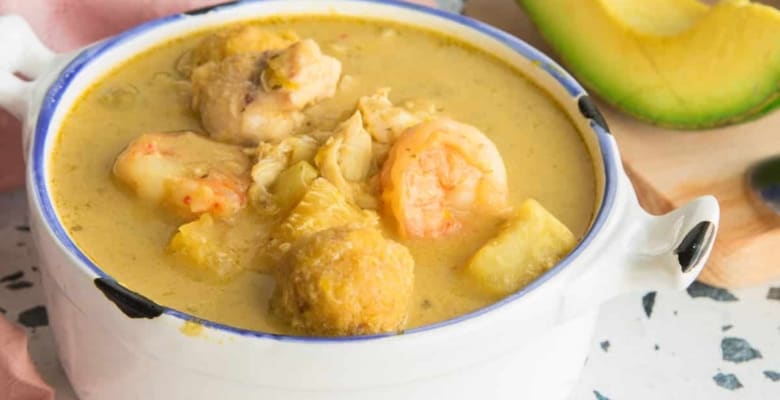
Caldo Santo (Puerto Rican Coconut Seafood Stew)
at Sense & EdibilityEquipment
- 8-quart Dutch oven
- box grater
Ingredients
- tablespoon (15 milliliters) olive oil or achiote oil
- 1 medium (1 1/2 cups or 200 grams) white onion peeled and thinly sliced
- 1/3 cup (85 grams) sofrito
- 5 cloves (2 tablespoons) garlic peeled and minced
- 1 1/2 inch piece (1 tablespoon) ginger peeled and minced
- 4 cups (1 liter) fish stock
- 3 cups (750 milliliters) coconut milk
- 1/4 cup (about 12) manzanilla olives
- 1 tablespoon capers
- 2 large bay leaves
- 1 tablespoon adobo plus more to taste
- 1 1/2 teaspoons (1 packet) sazón con achiote y culantro
- 1/2 teaspoon black pepper
- 1/4 teaspoon ground allspice optional
- 1/2 pound (455 grams) yuca (cassava) peeled and cut into 1/2-inch cubes
- 1/2 pound (455 grams) batata (boniato) peeled and cut into 1/2-inch cubes
- 1/2 pound (455 grams) calabaza (Kabocha squash) peeled and cut into 1/2-inch cubes
- 2 large green plantains
- 1 pound (460 grams) jumbo shrimp peeled and deveined
- 1 pound (460 grams) bacalao (salted cod) desalinated and cut into 1-inch chunks
- 1 pound (460 grams) red snapper cut into 1-inch chunks
- 1/2 pound (225 grams) lump crab meat
Optional Garnishes
- sliced avocado
- lime wedges
Instructions
Begin the Caldo Santo
- It in an 8-quart (or larger) Dutch oven or caldero, heat the olive oil over medium-high heat. Once the oil shimmers in the pot, add the sliced onion, sofrito, garlic, and ginger to the oil. Sauté these until glossy and opaque, or for 3 to 4 minutes, stirring frequently.
- Once the aromatics are glossy, pour in the fish stock and the coconut milk. Stir the liquids into the aromatics, then add the olives, capers, bay leaves, adobo, sazón, black pepper, and allspice to the pot. Allow the liquid to come up to a boil.
- Once the liquid in the pot starts to boil, stir in the chunks of yuca, batata, and calabaza. Bring the liquid back up to a boil.Once the liquid boils, reduce the temperature to medium and cover the pot. Gently simmer the viandas like this for 10 minutes, stirring every 5 minutes.
Peel and Grate the Platanos
- While waiting for the viandas to soften, peel the platanos. Cut the ends of the platanos off and make a slit down the back and front with the tip of your knife. Next, use the fleshy part of your thumb to press up on the peel to separate the peel from the platano. Continue pushing the peel up and away until the platano is peeled.
- Use the next to smallest grater holes to finely grate the platanos into a mixing bowl. Activate the platanos sticky quality by using your hand to stir the grated platano a bit in the bowl. Use a tablespoon measuring spoon or a #70 portion scoop to form 14-15 balls of platano.
- After you scoop the balls, roll each one between the palms of your hands to form them into round balls. If they don't stick together, you can add a small amount (1 tablespoon) of flour to help them along. Set the balls aside on a plate or platter while you wait for the viandas to finish their 10-minute simmer.
Finish the Caldo Santo
- Add the platano balls to the pot and use your spoon to push them under the surface of the caldo santo.Cover the pot and cook the platano balls in the soup for 5 minutes.
- After 5 minutes, dump all seafood except for the crab meat into the pot. Stir it in and cover the pot once again. Cook the caldo santo for 10 minutes or until the seafood is cooked all the way through.
- Turn off the stove and immediately stir the crab meat into the cooked caldo santo. Avoid stirring the soup too much as this will cause the crab meat to break apart. Ladle the caldo santo into individual serving bowls to serve it.
- Serve the caldo santo with slices of toasted and buttered Pan Sobao, ripe avocado slices and lime wedge for squeezing into the soup just before eating.
Notes
Swaps and Substitutions:
- Replace the fresh coconut milk with canned coconut milk.
- Vianda swaps: butternut squash or acorn squash, malanga coco (yautía, big taro or cocoyam),ñame (yam),Russet or Yukon Gold potatoes,guineos verdes (green cooking bananas).
- If you don't want to use salted codfish, you can replace it with fresh cod, but you will need to add more adobo to the soup. More bacalao swaps: salted pollock, haddock, or flounder.
- Red snapper substitutes include grouper, sea bass, or orange roughy.
- Replace the shrimp with scallops, crawfish, or langostino.
- You can replace lump crab meat with chunks of lobster, more shrimp, or tenderized octopus.
Tips and Techniques:
- Use bright green, firm plantains for this recipe. Yellow plantains will be too sweet in this dish.
- You can omit the platano balls if you don't want to add them or just peel and cut the plantains into 1/2-inch thick slices. Add sliced plantains with the other viandas.
- You can also make the bolitas out of guineos verdes instead of platanos. Peel, grate, scoop and form them the same way you did the platanos.
- Seafood shouldn't cook too long, or it will toughen.
- Packaged crab meat is pre-cooked, so it's safe to add to the soup after cooking.
Make-Ahead Instructions:
- For the Platano Balls:
- Grate and form the platanos as instructed. Lay the platano balls onto a greased sheet pan or a sheet pan lined with a silicone baking mat.
- Place a piece of plastic wrap over the platano balls and freeze until solid.
- Remove the platano balls from the sheet pan once frozen and transfer them to a food storage bag. Freeze the platano balls for up to 6 months.
- To use them, just toss them into whatever you want. Make sure to boil the plantain balls for at least 10 minutes to ensure they're cooked throughout.
Storage Instructions:
- Store leftover caldo santo in the fridge for up to 3 days. You can reheat the portions you plan to serve and eat in the microwave or on the stovetop until warmed through. Discard any remaining soup after 3 days.
- Freeze caldo santo for up to 2 months:
- Transfer the cooled soup to a freezer-safe container and freeze it.
- Thaw the frozen caldo santo in the fridge overnight and reheat as instructed above.

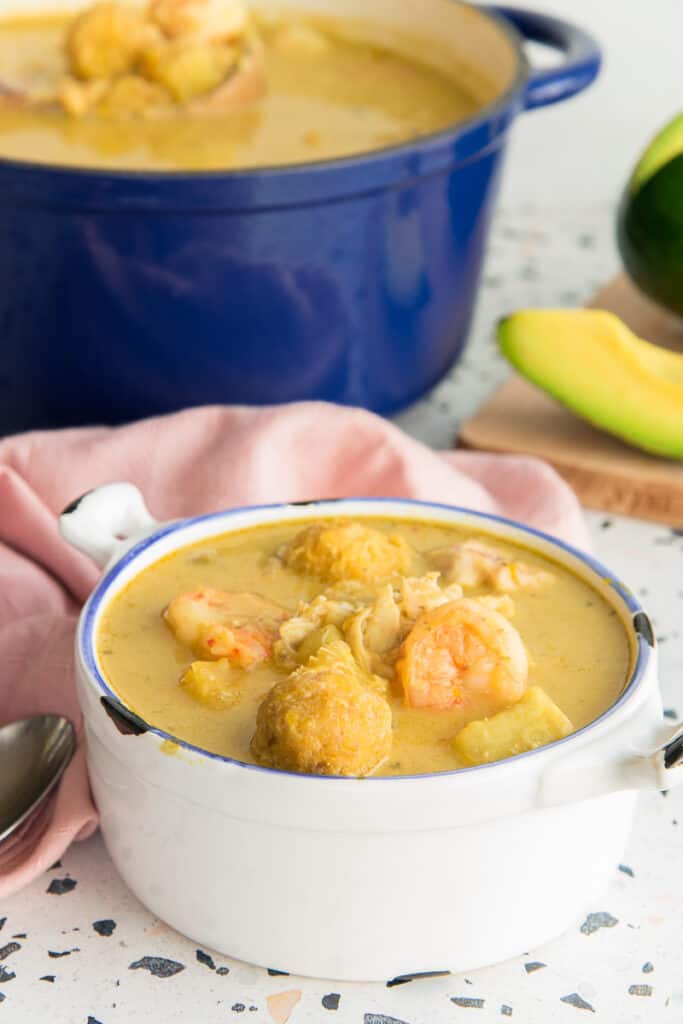
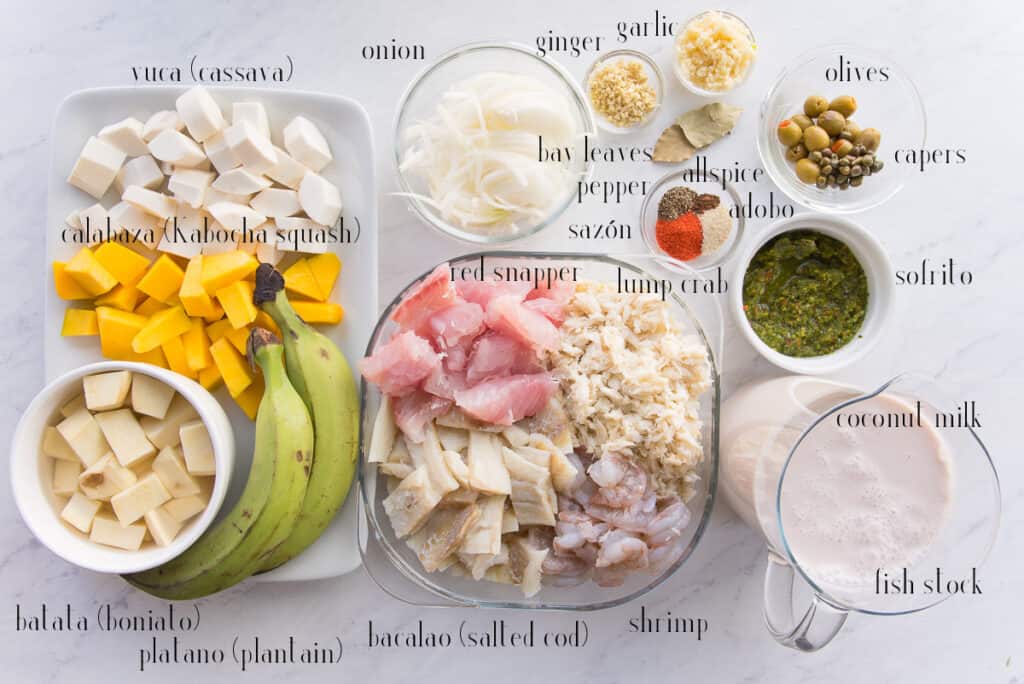
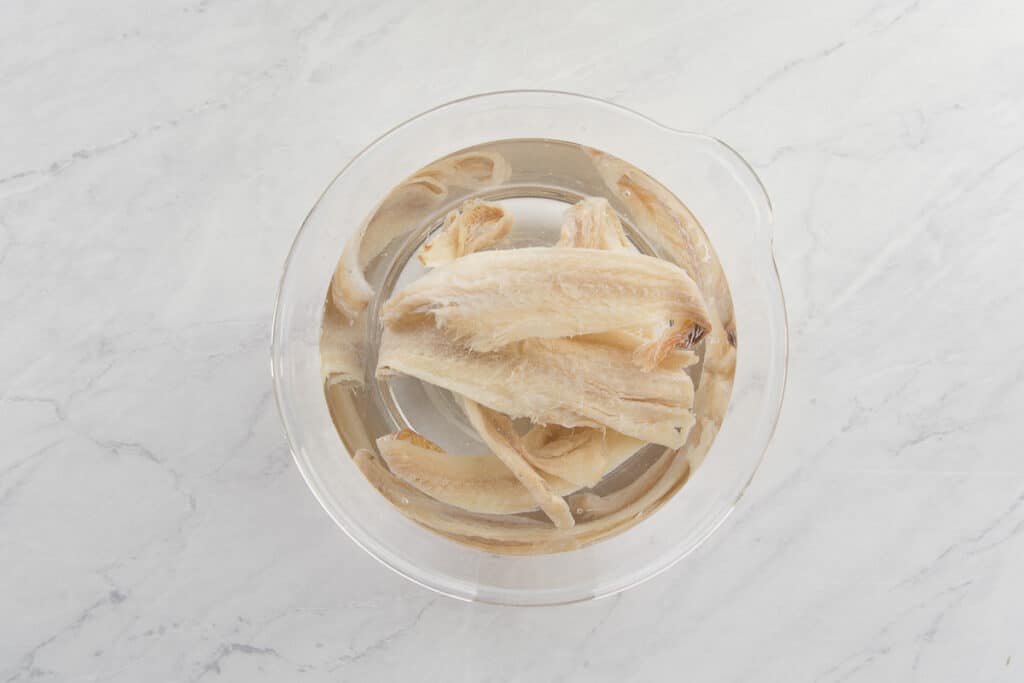
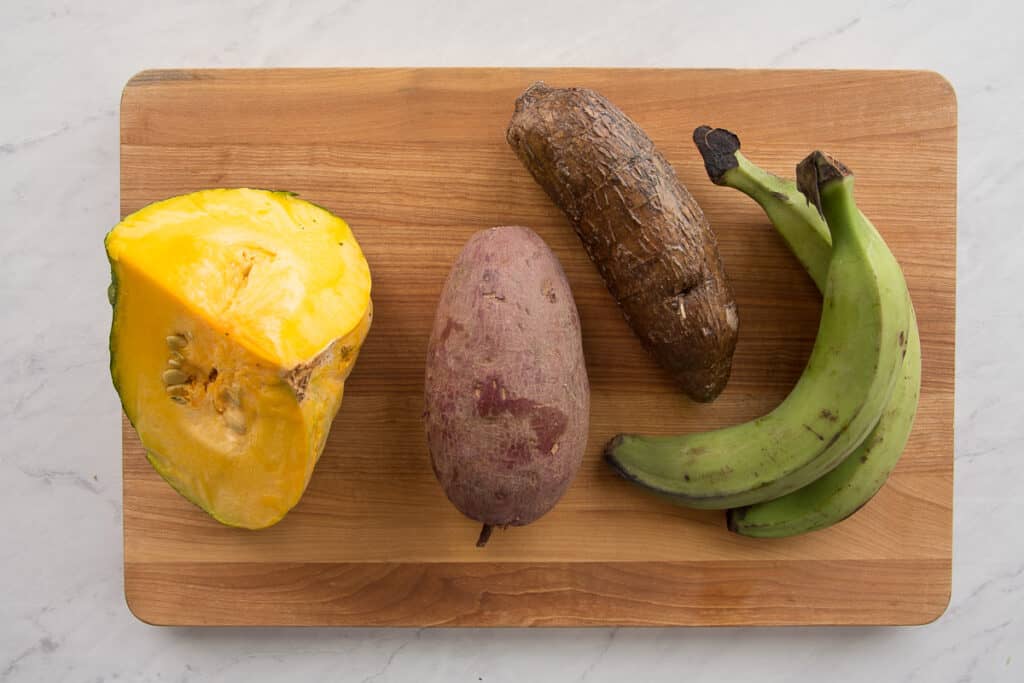
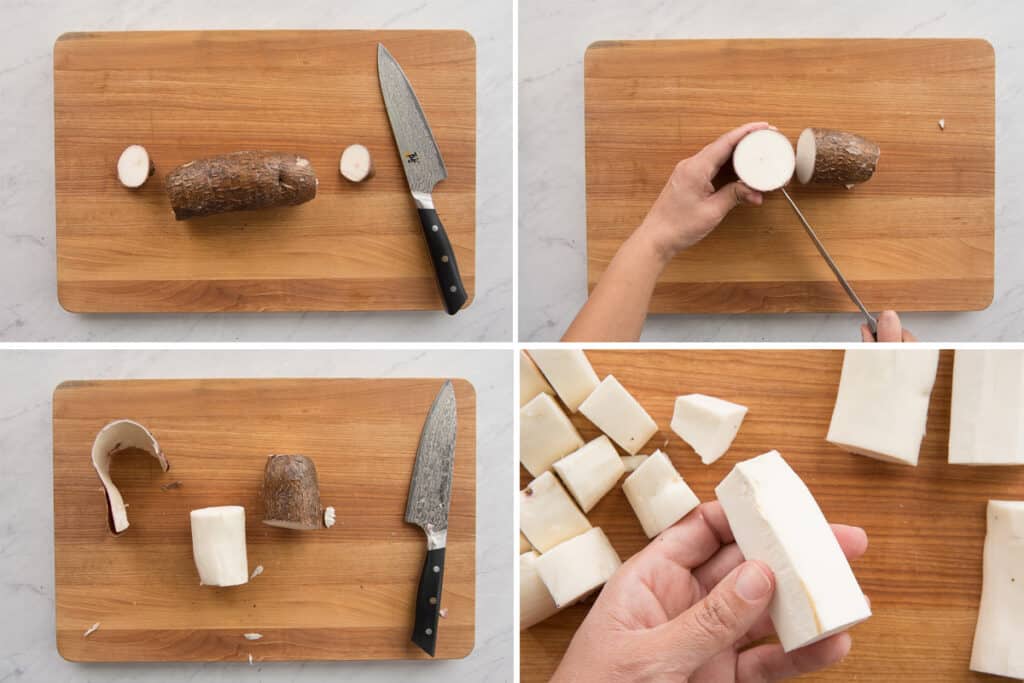
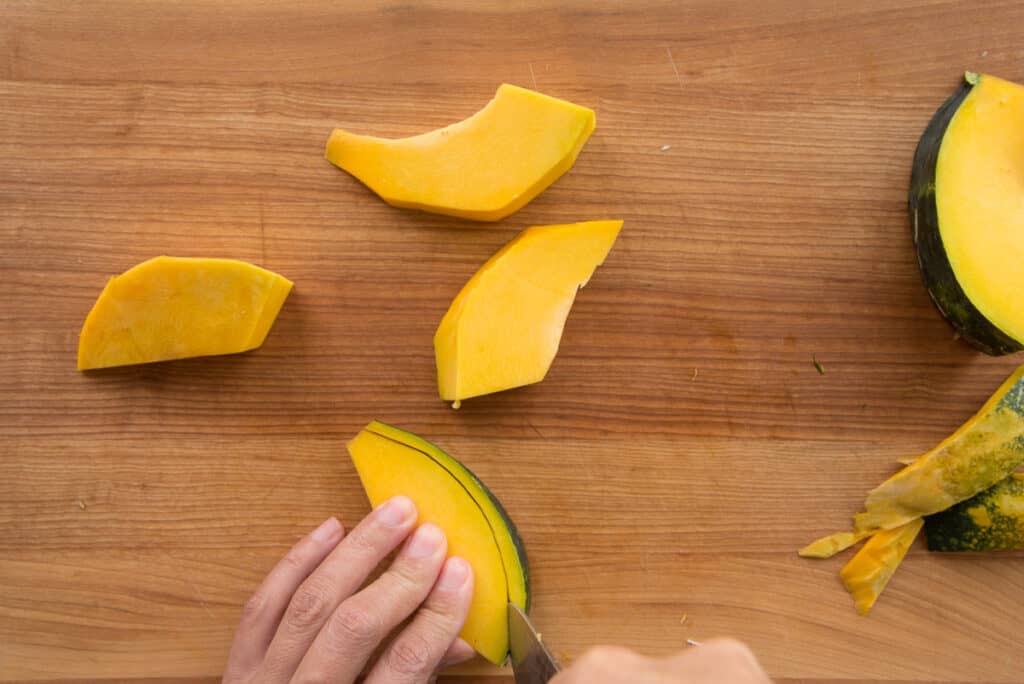
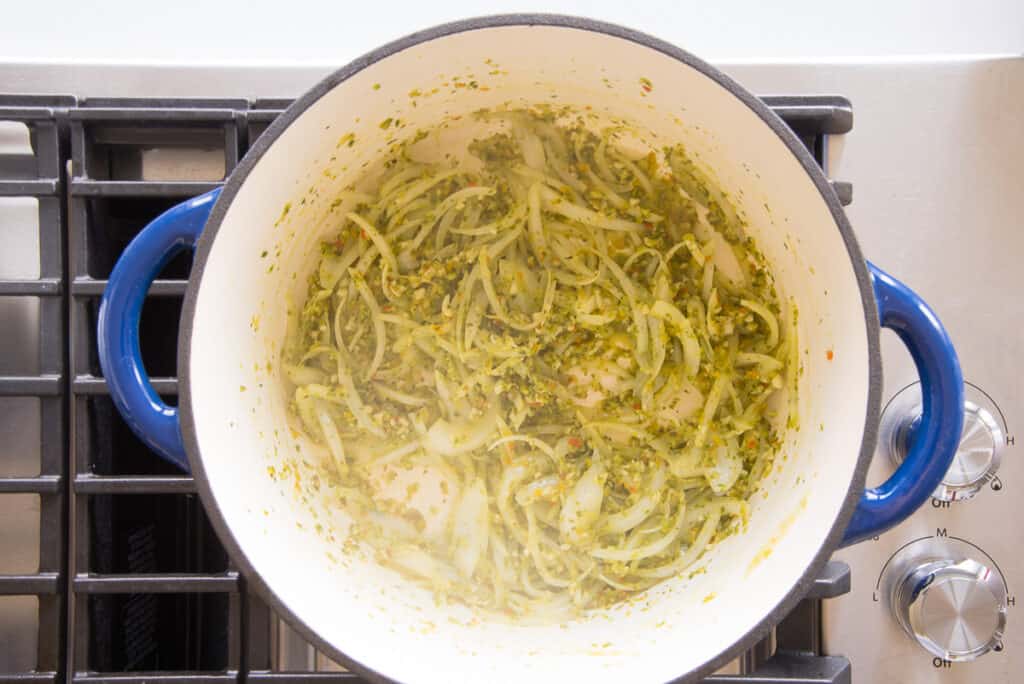
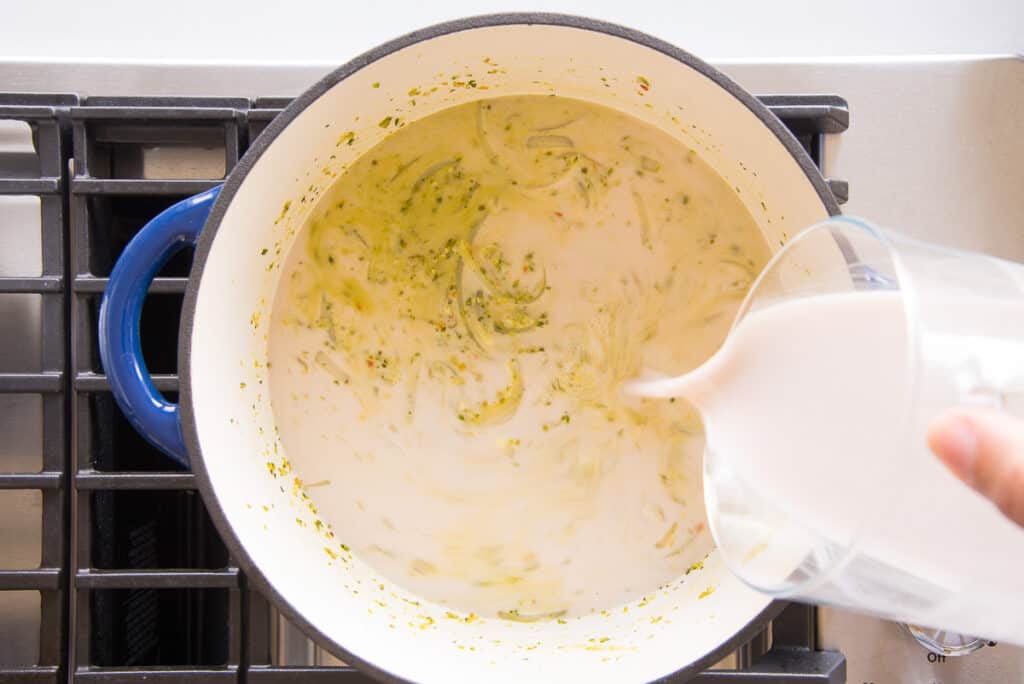
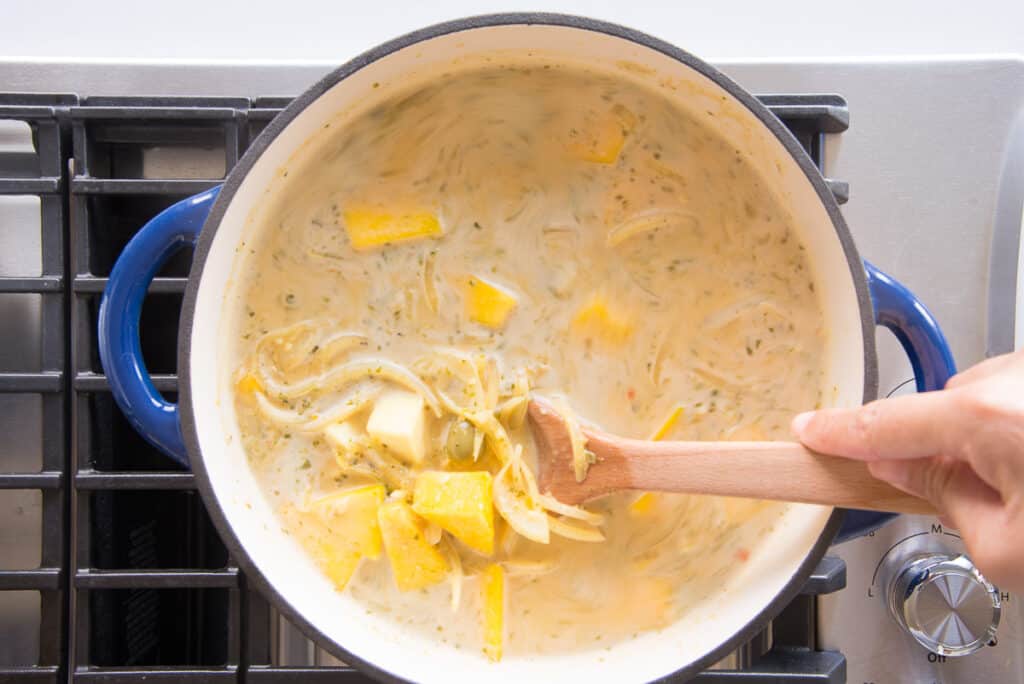
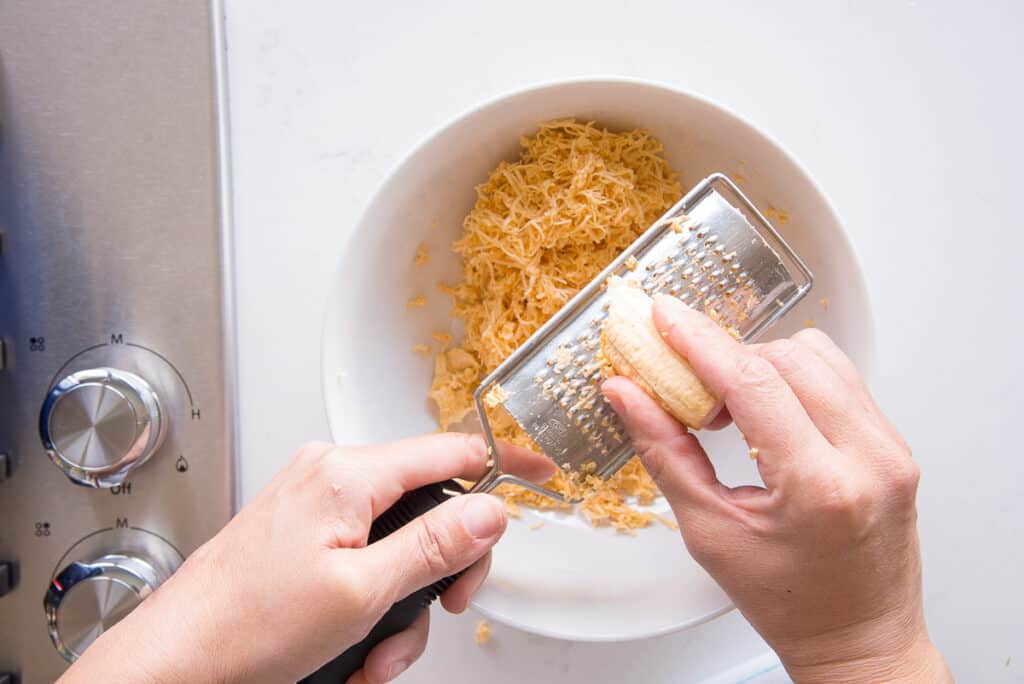
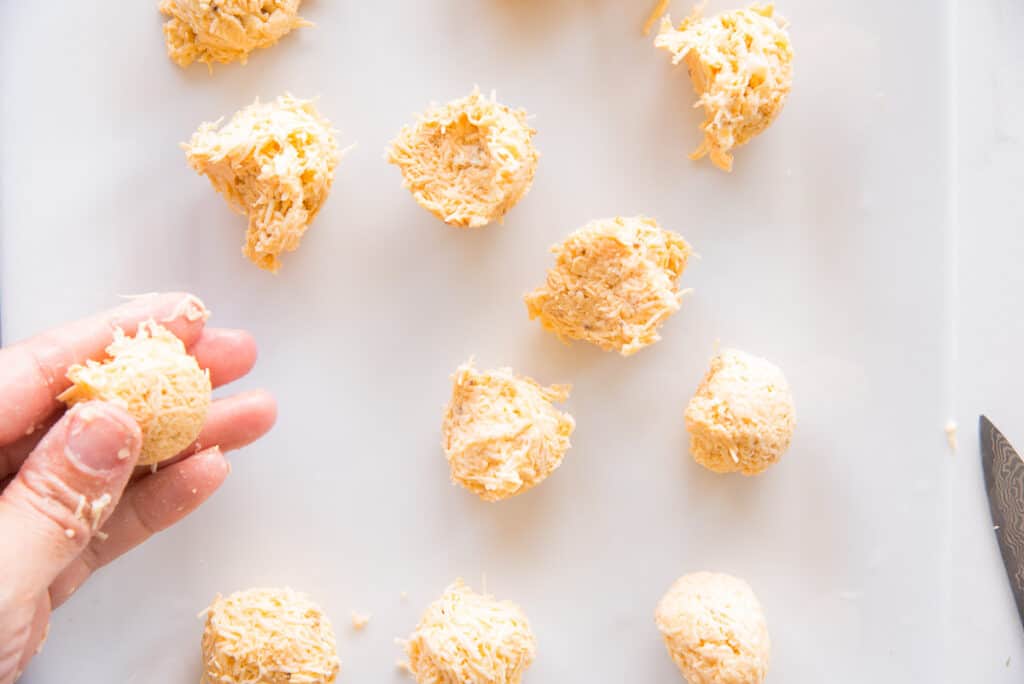
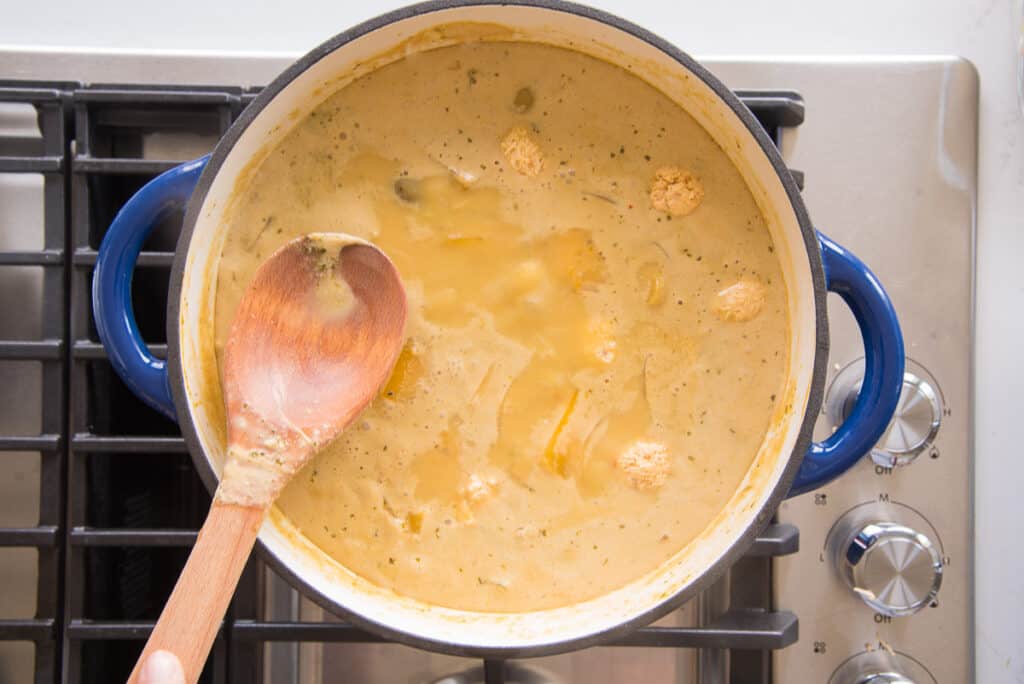
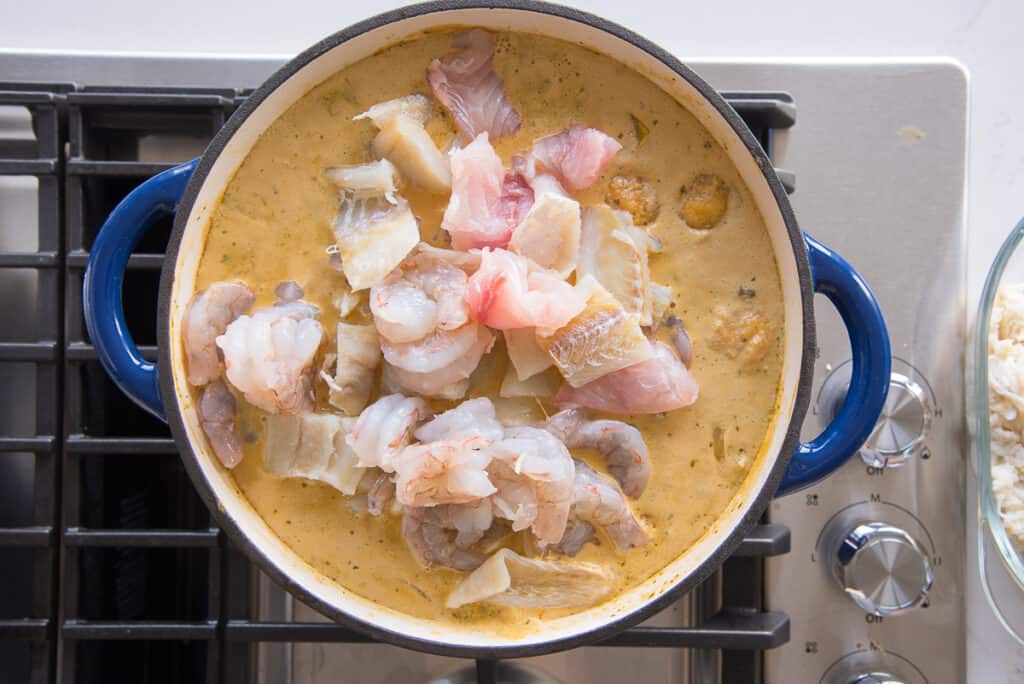
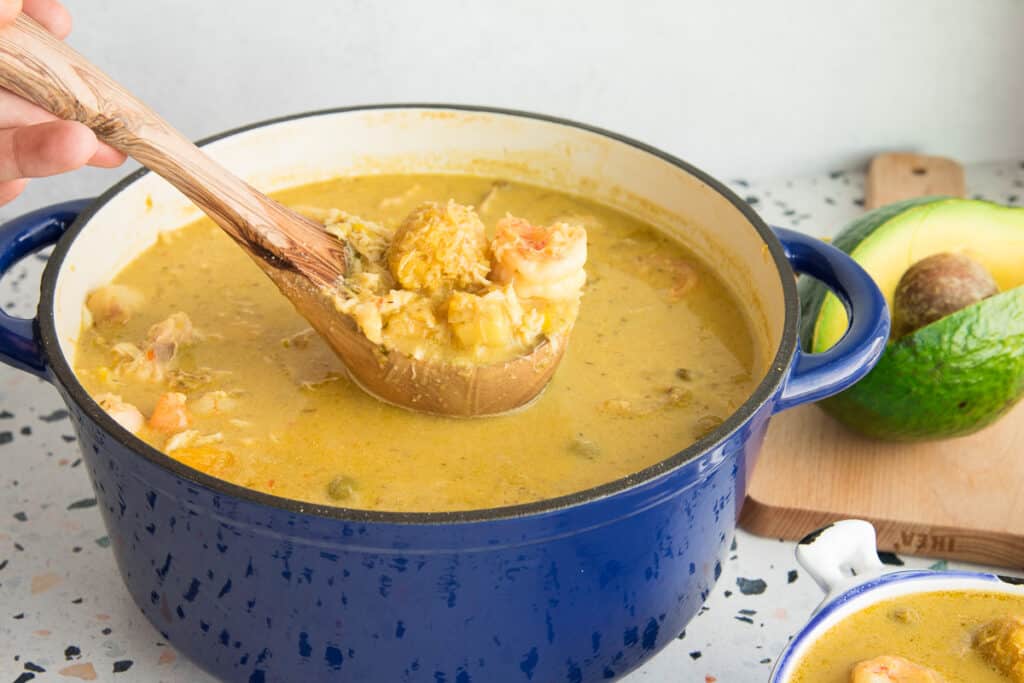
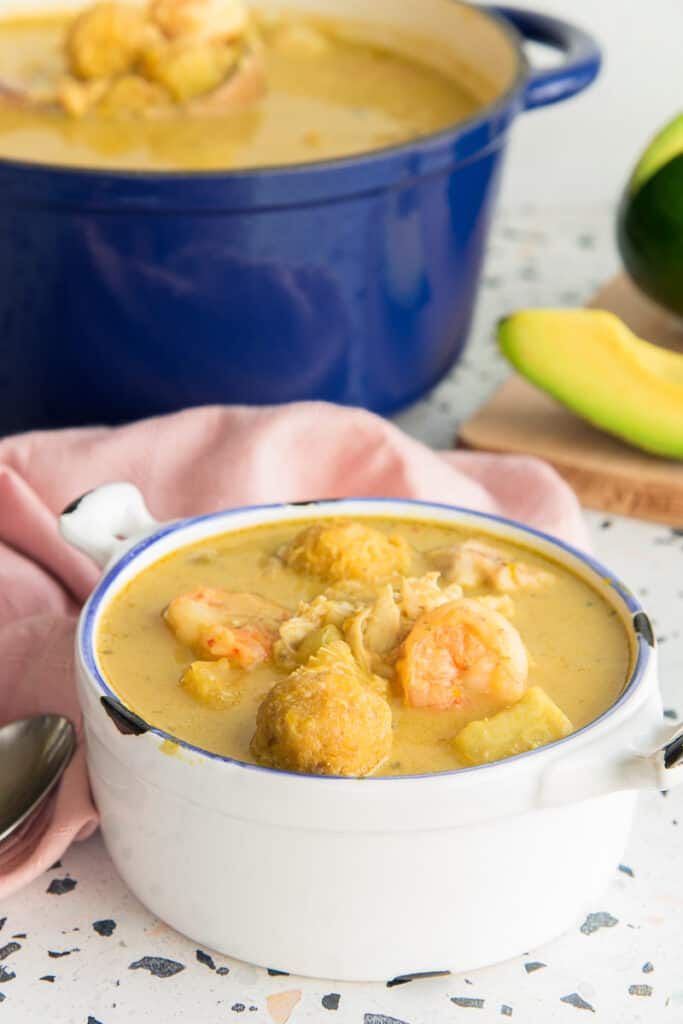
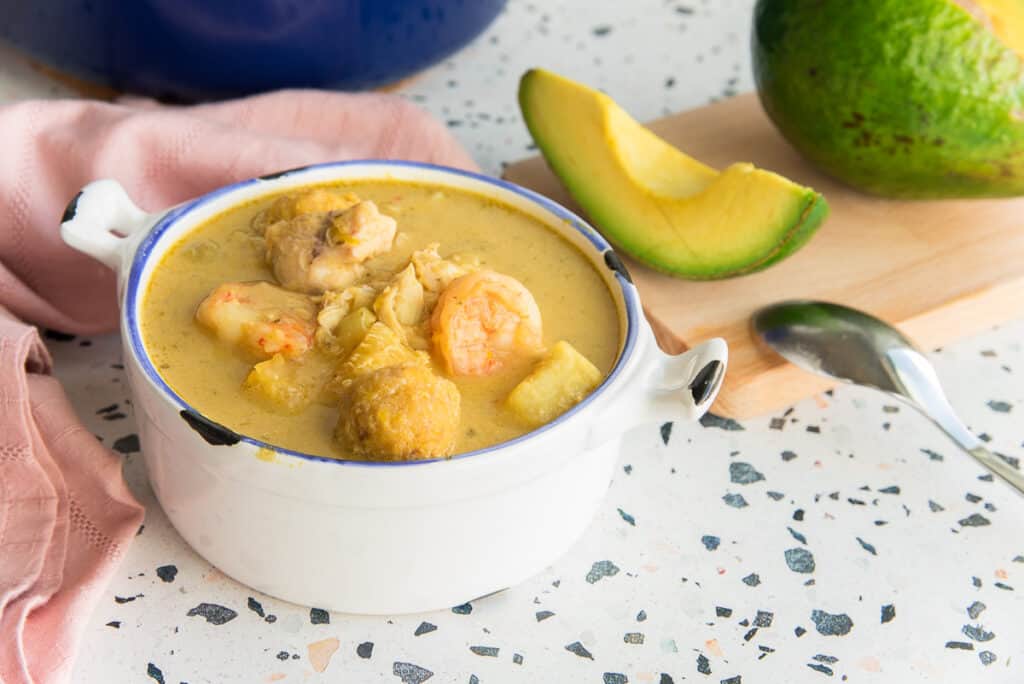

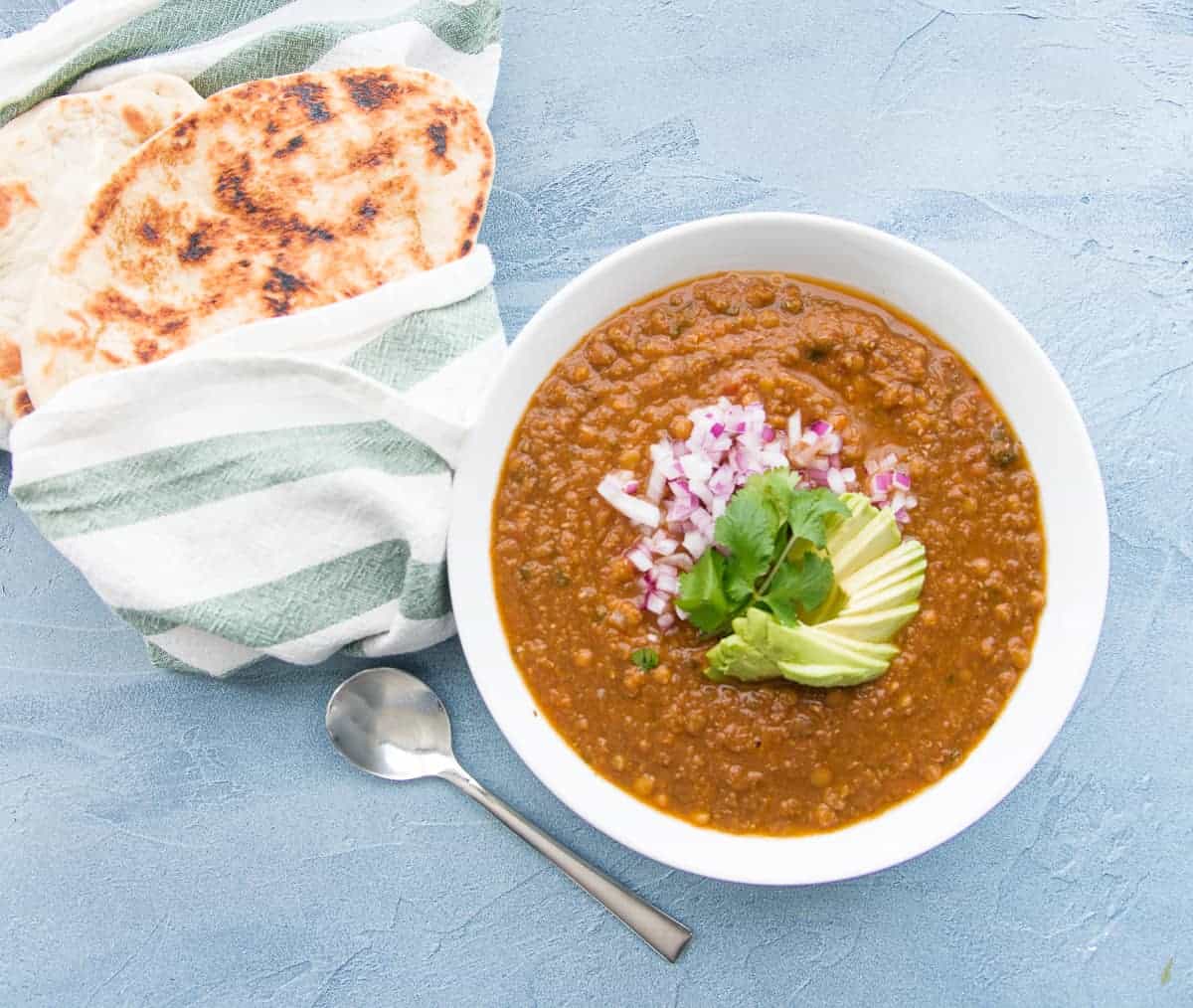



Made this last weekend and it was a huge success! Delicious recipe, thank you.
You’re welcome. Glad to hear you enjoyed it!
This is holy, for sure! Made it for Good Friday and it low-key felt like a sin. Even as someone who doesn’t love seafood, the freshness of the ingredients and coconut hint did the trick for me. Not to even mention the seconds and thirds my guest had. There was nothing left!
But… it’s a holy sin, right? 😉
I enjoyed some of the best seafood of my life in Loiza. This stew reminded me of that–it is delicious and so flavorful. Thank you.
I miss Loíza, Jazz! Glad I could bring back good memories.
I’m obsessed with your stews at the moment! This seafood stew is probably my favorite yet. The coconut milk base had me drooling, the seafood added sooo much flavor and the plantain and yam hit the spot. This stew is comfort food goals!
I’m glad to read that, Jen. That is my goal.
This stew warmed my soul tonight! I was so excited to make it and it lived up to every expectation!
Awesome, Chenee!
Seafood stews have always been what I gravitate to more than beef stew. So, I’m grateful for this amazing recipe, it was well worth the effort!
Thank you, Robin!